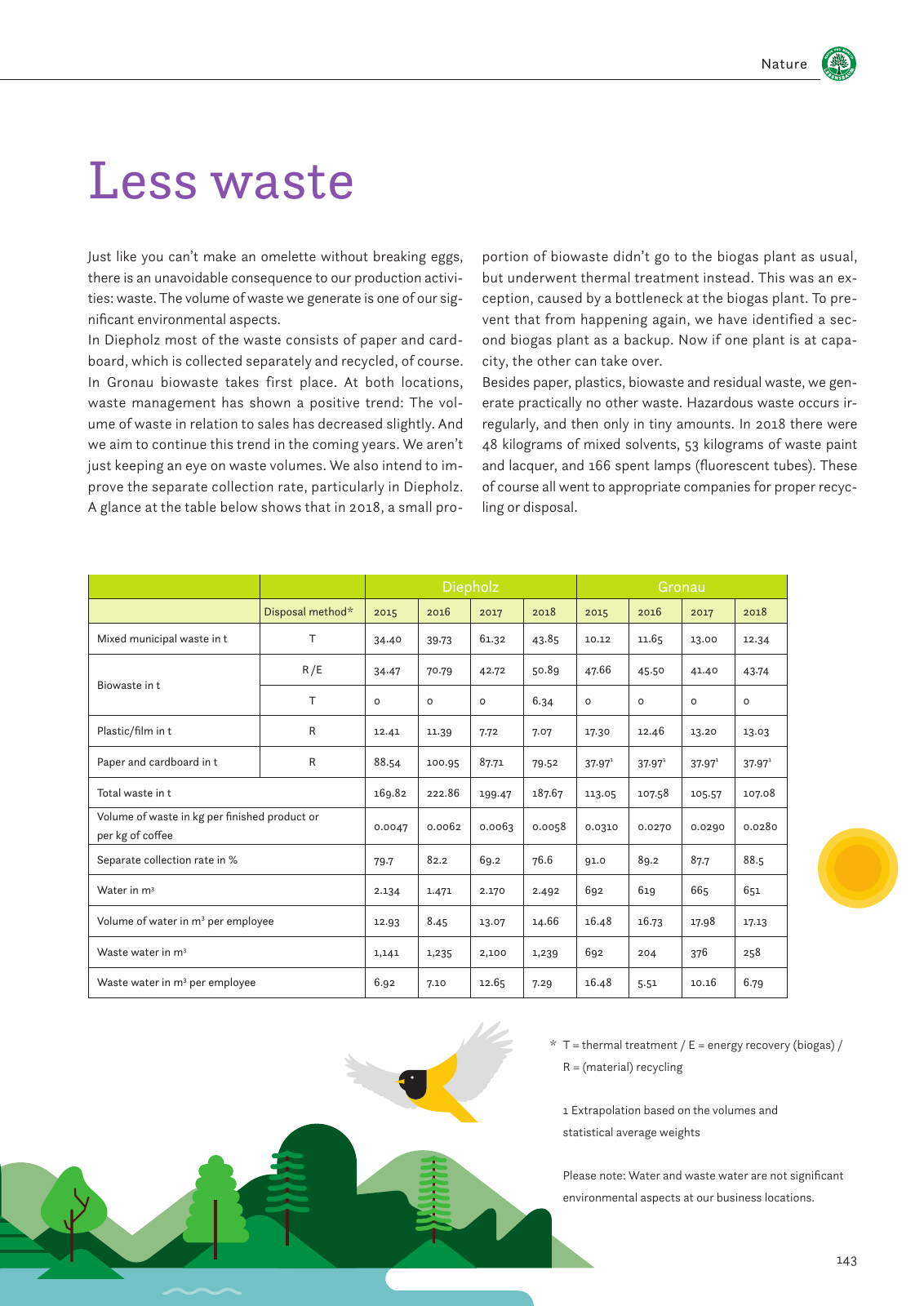143 Nature Diepholz Gronau Disposal method 2015 2016 2017 2018 2015 2016 2017 2018 Mixed municipal waste in t T 34 40 39 73 61 32 43 85 10 12 11 65 13 00 12 34 Biowaste in t R E 34 47 70 79 42 72 50 89 47 66 45 50 41 40 43 74 T 0 0 0 6 34 0 0 0 0 Plastic film in t R 12 41 11 39 7 72 7 07 17 30 12 46 13 20 13 03 Paper and cardboard in t R 88 54 100 95 87 71 79 52 37 971 37 971 37 971 37 971 Total waste in t 169 82 222 86 199 47 187 67 113 05 107 58 105 57 107 08 Volume of waste in kg per finished product or per kg of coffee 0 0047 0 0062 0 0063 0 0058 0 0310 0 0270 0 0290 0 0280 Separate collection rate in 79 7 82 2 69 2 76 6 91 0 89 2 87 7 88 5 Water in m3 2 134 1 471 2 170 2 492 692 619 665 651 Volume of water in m3 per employee 12 93 8 45 13 07 14 66 16 48 16 73 17 98 17 13 Waste water in m3 1 141 1 235 2 100 1 239 692 204 376 258 Waste water in m3 per employee 6 92 7 10 12 65 7 29 16 48 5 51 10 16 6 79 T thermal treatment E energy recovery biogas R material recycling 1 Extrapolation based on the volumes and statistical average weights Please note Water and waste water are not significant environmental aspects at our business locations Less waste Just like you can t make an omelette without breaking eggs there is an unavoidable consequence to our production activi ties waste The volume of waste we generate is one of our sig nificant environmental aspects In Diepholz most of the waste consists of paper and card board which is collected separately and recycled of course In Gronau biowaste takes first place At both locations waste management has shown a positive trend The vol ume of waste in relation to sales has decreased slightly And we aim to continue this trend in the coming years We aren t just keeping an eye on waste volumes We also intend to im prove the separate collection rate particularly in Diepholz A glance at the table below shows that in 2018 a small pro portion of biowaste didn t go to the biogas plant as usual but underwent thermal treatment instead This was an ex ception caused by a bottleneck at the biogas plant To pre vent that from happening again we have identified a sec ond biogas plant as a backup Now if one plant is at capa city the other can take over Besides paper plastics biowaste and residual waste we gen erate practically no other waste Hazardous waste occurs ir regularly and then only in tiny amounts In 2018 there were 48 kilograms of mixed solvents 53 kilograms of waste paint and lacquer and 166 spent lamps fluorescent tubes These of course all went to appropriate companies for proper recyc ling or disposal

Hinweis: Dies ist eine maschinenlesbare No-Flash Ansicht.
Klicken Sie hier um zur Online-Version zu gelangen.
Klicken Sie hier um zur Online-Version zu gelangen.